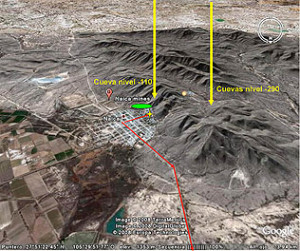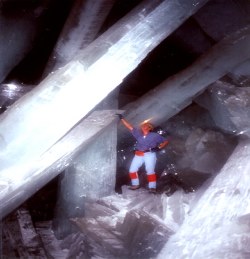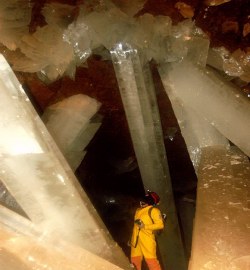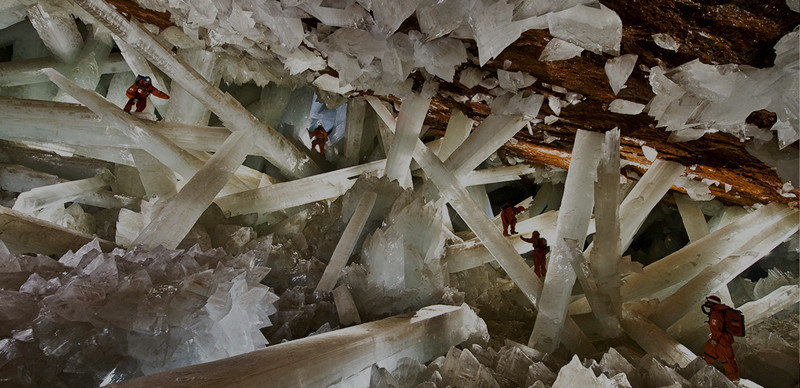Mexico’s mysterious crystal cave
By LOGAN HAWKES
Mysterious, alluring and deadly, there’s a natural cave in Northern Mexico hidden from the casual observer, buried deep beneath a silver mine and threatened by the industry that uncovered it. And should it one day (soon) disappear, destroyed by human intrusion, its loss will be monumental, the destruction of a place so rare and magnificent that it could hold a magnitude of secrets about the Earth and how it was formed – and what it looked like hundreds of thousands of years ago before man ever walked the planet.
Known simply as the Crystal Cave, or Cueva de los Cristales, this geologic wonder represents a milestone of discovery, a cave of gigantic crystals that reach from floor to ceiling filling the chamber with an other-worldy appearance and where the environment is so hot and humid that those brave enough to venture into its perplexing structure run the risk of never leaving because of the extreme heat that can suck the life from your lungs in as little as twenty minutes. Some call it a Fortress of Solitude because of its remarkable likeness to Superman’s fabled getaway as portrayed in the popular movies about the legendary Kryptonian.

location of crystal cave. (Google Earth)
Near the quiet town of Naica in Mexico’s Chihuahuan Desert, the Crystal Cave lies 1,000 feet below the surface of the desert. It was discovered by a pair of brothers drilling in the Naica mine, Mexico’s most productive mining operation that yields thousands of tons of silver and lead each year. The limestone cavern is alive with magnificent beams of selenite crystal, many of them several feet thick and stretching from floor to ceiling in the cavern chamber. Above them, hanging from the rocky ceiling, are smaller chunks of crystal, sharp as knives and pointed like daggers.
Selenite is translucent and soft, making the huge pillars vulnerable to human activity. But only a few dozen men have ventured into this eerie chamber, protected by the Peñoles Mining Company and hidden away behind a great steel door that keeps miners isolated from the natural wonder. While the heavy door and remote location protect the crystal, it also helps to protect those who unwisely attempt to venture to the depths, for inside the crystal chamber temperatures rise as high as 115-degrees Fahrenheit, heated by a magma flow below the chamber floor. Scientists who have explored and studied the cave are required to wear protective suits packed with ice, and even so their visits to the mysterious chamber are limited to 20 minutes or so before the heat and humidity force them to surface for air.

The crystal obelisks formed over the last 600,000 years according to geological research. For thousands of years groundwater saturated with calcium sulfate filtered through the caves at Naica, heated by the magma flow beneath. As the magma cooled, temperature inside the cave stabilized and minerals in the water began converting to selenite.
But what has taken thousands of years to form could be destroyed in less than a decade, and along with it the secrets it holds. The crystal cave was discovered only after miners lowered the ground water level in the Naica mine, unveiling additional chambers deeper in the earth. But it was the heated water that gave the crystal life, and now that the cavern is dry, scientist warn that the decaying process had started.
Also of major concern is the illegal taking of crystal samples.Mine officials report they have thwarted attempts, often by mine employees, to remove pieces, even large sections of the delicate crystals. They warn that crystal collectors worldwide have expressed interest in museum quality shards, for which they would pay substantial bounty to own.

But deep within the great pillars of selenite crystal are earth secrets that scientists are hard at work trying to unravel. Scientists from around the world are working with fury to catalogue the mysteries the crystals hold. Spanish crystallographer Juan Manuel García-Ruiz has been working on discovering the secrets of how the crystals formed and came to grow so incredibly large. Penelope Boston, an associate professor of cave science at New Mexico Tech, and Italian scientist Anna Maria Mercuri, are studying tiny microbes trapped inside the crystals for thousands of years that may hold the answers to what life was like on planet earth a half million years ago. Already they have determined that the desert above was once covered by a massive forest. What other secrets the cavern’s crystals may hold no knows for certain, but the academic world has speculated that the knowledge there may be beyond our current understanding, and a few have suggested there may be evidence to lead researchers to discovering not only the secrets of the planet, but the Universe at-large.
Though the public can not venture into the depths to view the Cave of Crystals, a visit there by miners, scientists and the few film crews granted permission to document the natural wonder say the cavern offers a mysterious environment that can only be explained by calling it “other-worldly”. But even the select few who are allowed within the depths of Naica mine may soon lose their chance to document its wonders. The caves are accessible today only because the mining company’s pumping operations keep them clear of water. If the pumping were stopped, the caves would again be submerged. Officials at the mining company say they may stop pumping water out of the cavern within the next year or two.
For more detailed information on the project and some really great photos go to the official Naica Penoles Project website.
* * *
 ABOUT THE AUTHOR: Logan Hawkes
ABOUT THE AUTHOR: Logan Hawkes
We regret to report that Logan Hawkes passed away in February 2020. He was an award-winning writer, researcher, publisher, broadcaster and adventurer and publisher. He served as a guest and contributor to the History Channel, hosted the syndicated radio talk show, “Travel Quest”, and authored various history-based books, stories and docudramas. RIP Logan.


